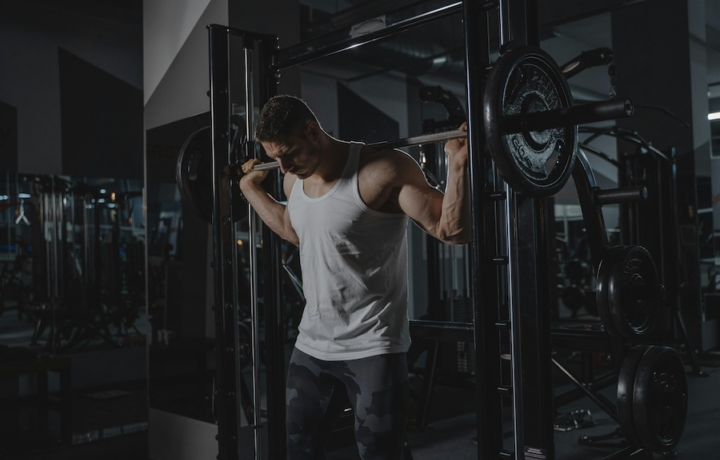Exercise
Barbell Sumo Deadlift

Barbell Sumo Deadlift
How to Perform
- Position your feet wider than shoulder-width apart with toes pointing outward at 45 degrees, and center the barbell over your midfoot.
- Hinge at the hips to lower your body, maintaining a neutral spine as you grip the barbell inside your legs with hands shoulder-width apart.
- Brace your core by taking a deep breath into your diaphragm and engaging your abdominal muscles to stabilize your spine.
- Drive your knees outward to align with your toes, keeping your chest up and shoulders pulled back and down.
- Initiate the lift by pressing your feet into the floor while simultaneously driving your hips forward, maintaining tension throughout your body.
- As the bar passes your knees, exhale gradually while continuing to extend your hips and knees until you reach a fully upright position.
- At the top position, stand tall with shoulders back, glutes squeezed, and knees soft but not locked.
- Lower the weight by hinging at the hips first, then bending the knees to return the barbell to the floor under control, maintaining your braced core throughout the descent.
Important information
- Keep your lower back neutral (not rounded or excessively arched) throughout the entire movement to protect your spine.
- Drive through your heels and midfoot rather than your toes to maximize leg engagement and maintain proper balance.
- Make sure your knees track in the same direction as your toes to prevent unnecessary stress on your knee joints.
- If you feel the movement primarily in your lower back rather than your glutes and hamstrings, reassess your form and consider reducing the weight.

Barbell Sumo Deadlift
Exercise Details
Primary Muscles
Muscle Groups
Mechanic
Risk Areas
Built for progress
Take the guesswork out of training
Create personalized AI-powered workout plans that evolve with you. Train smarter, track every rep and keep moving forward, one workout at a time.






The Barbell Sumo Deadlift stands as one of the most effective compound movements for developing lower body strength and power. This intermediate-level exercise primarily targets the glutes, hamstrings, and quadriceps while also engaging the entire posterior chain. Unlike the conventional deadlift, the sumo variation utilizes a wider stance with toes pointed outward, which shortens the range of motion and places greater emphasis on the inner thighs and glutes.
Popular in both powerlifting and bodybuilding circles, the sumo deadlift offers versatility for various training goals. Powerlifters often embrace this technique for its mechanical advantage, allowing many lifters to move heavier loads than with conventional stance. Meanwhile, bodybuilders appreciate the sumo deadlift's ability to develop thick, powerful legs and a well-rounded physique with special emphasis on the outer sweep of the quadriceps and the glute-hamstring tie-in.
What makes the sumo deadlift particularly valuable is its transferable strength benefits. The movement pattern reinforces proper hip hinging, which carries over to numerous athletic movements and daily activities. Research has shown that regular deadlifting can significantly improve bone density, making it an excellent exercise for long-term skeletal health and injury prevention.
From a physiological perspective, the sumo deadlift triggers a substantial hormonal response, elevating testosterone and growth hormone levels when performed with challenging weights. This makes it an excellent choice for those looking to maximize their body's natural anabolic environment. The exercise also delivers impressive caloric expenditure due to the large muscle groups involved, making it valuable for both muscle-building and fat loss phases.
While the sumo stance might feel unnatural at first for those accustomed to conventional deadlifting, many lifters with certain anatomical structures—particularly those with longer torsos or limited hip mobility—find the sumo position more comfortable and mechanically advantageous. This accessibility makes it an excellent variation to include in any comprehensive strength training program, regardless of whether your ultimate goal is raw strength development or aesthetic enhancement.
FAQ - Barbell Sumo Deadlift
The sumo deadlift primarily targets the glutes, quadriceps, and adductors (inner thighs) more than conventional deadlifts. While both variations work the entire posterior chain, the wider stance in sumo shifts emphasis to the inner thighs and places less stress on the lower back.
No, the sumo deadlift is not cheating—it's simply a different technique that may be more biomechanically advantageous for certain body types, particularly those with longer torsos or limited hip mobility. Both variations are legitimate, effective exercises with slightly different muscle emphasis.
Your sumo stance should be wide enough that your shins are vertical and your arms can reach the bar inside your legs, typically with feet near the rings on the barbell. Experiment to find where you feel most powerful—your optimal width depends on your hip structure and mobility.
The most common sumo deadlift mistakes include starting with hips too low (like a squat), not driving knees out to track with toes, and pulling before creating tension. Focus on "wedging" yourself into position, keeping your chest up, and pushing the floor away rather than lifting with your back.
Break through sumo deadlift plateaus by addressing your weakest link—often adductor/hip strength or upper back stability. Incorporate accessory work like banded sumo pulls, pause deadlifts at knee level, and exercises that strengthen your upper back and core to maintain proper positioning under heavy loads.







